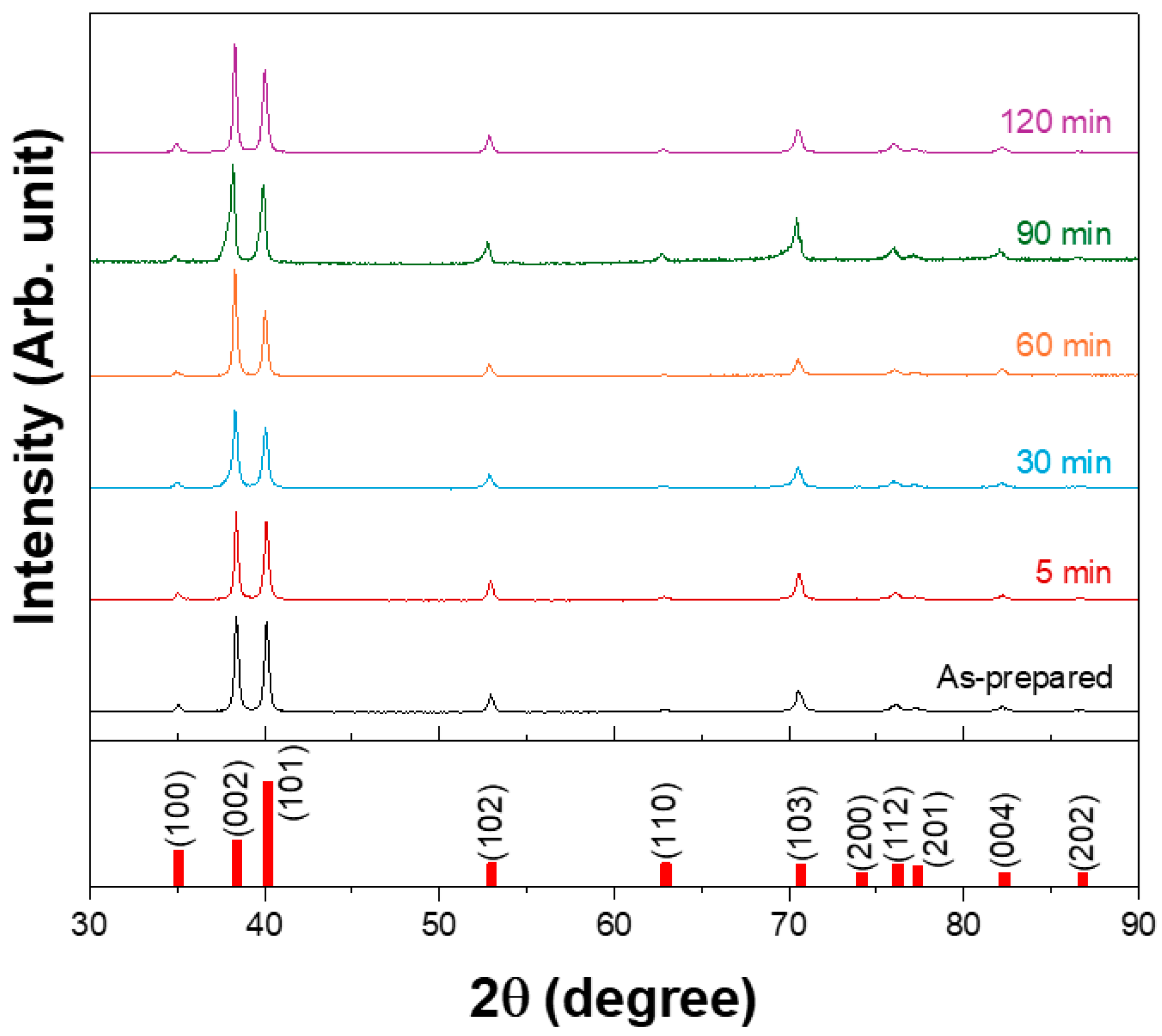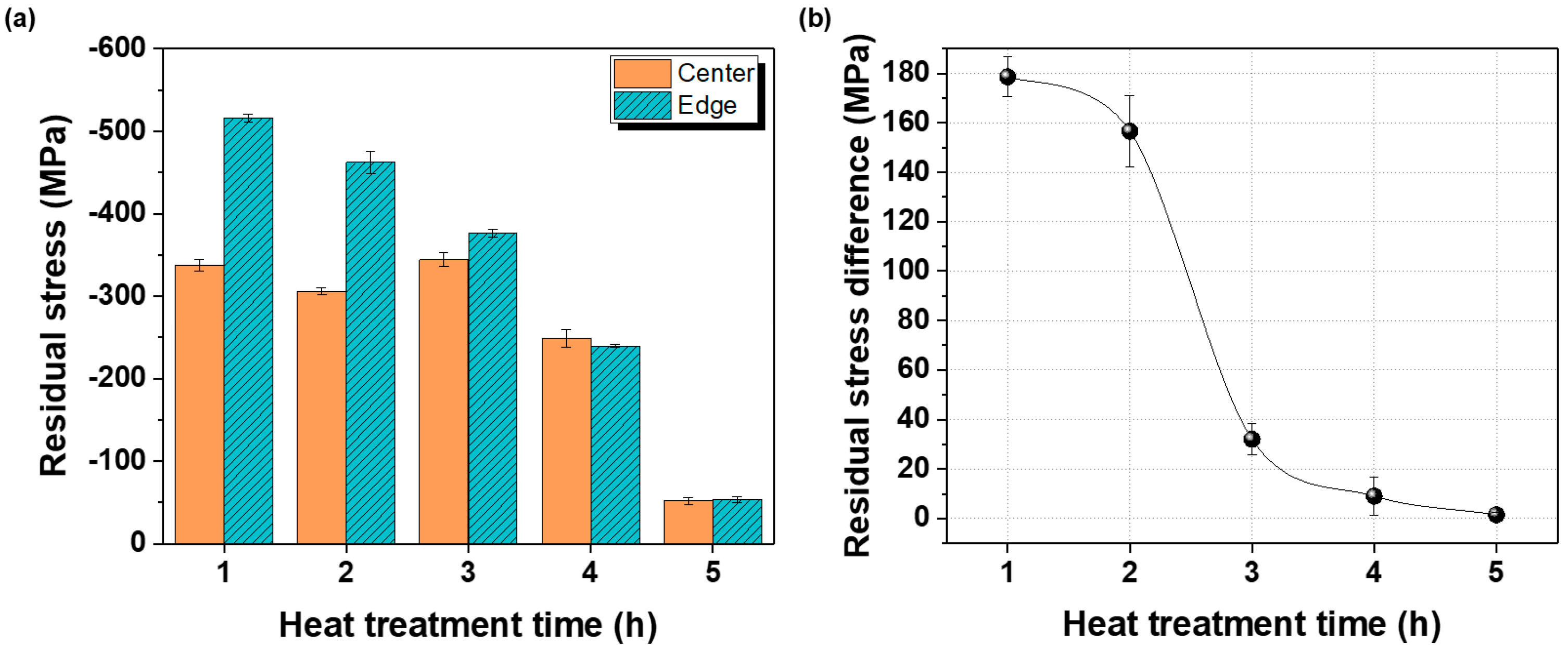Microstructural and Residual Stress Homogenization of Titanium Sputtering Targets for OLED 6G Applications Through Controlled Rolling and Heat Treatment
Abstract
1. Introduction
- They should have high purity exceeding 3N (≥99.9%) to reduce particulate contaminations and prevent abnormal discharges during sputtering.
- They must exhibit high density and a homogenous microstructure. Importantly, they should be free of non-uniform macro patterns to preserve film uniformity.
- The average grain size should be under 70 μm, with grain-sized variations maintained below 20%, and crystallographic orientation spread limited to under 10%.
- Adequate mechanical strength is required to ensure stable operation during high-rate sputtering without cracking or structural failure.
2. Materials and Methods
3. Results and Discussion
4. Conclusions
- Phase and texture development
- 2.
- Effect of heat treatment temperature of 600 °C
- 3.
- Effect of heat treatment temperature of 700 °C
Supplementary Materials
Funding
Institutional Review Board Statement
Informed Consent Statement
Data Availability Statement
Acknowledgments
Conflicts of Interest
References
- Ji, D.; Jang, J.; Park, J.H.; Kim, D.; Rim, Y.S.; Hwang, D.K.; Noh, Y.Y. Recent Progress in the Development of Backplane Thin Film Transistors for Information Displays. J. Inf. Disp. 2021, 22, 1–11. [Google Scholar] [CrossRef]
- Wei, D.-M.; Zheng, H.; Tan, C.-H.; Zhang, S.; Li, H.-D.; Zhou, L.; Chen, Y.; Wei, C.; Xu, M.; Wang, L.; et al. Pixel Circuit Designs for Active Matrix Displays. Appl. Syst. Innov. 2025, 8, 46. [Google Scholar] [CrossRef]
- Aydin, E.; Altinkaya, C.; Smirnov, Y.; Yaqin, M.A.; Zanoni, K.P.S.; Paliwal, A.; Firdaus, Y.; Allen, T.G.; Anthopoulos, T.D.; Bolink, H.J.; et al. Sputtered Transparent Electrodes for Optoelectronic Devices: Induced Damage and Mitigation Strategies. Matter 2021, 4, 3549–3584. [Google Scholar] [CrossRef]
- Anthopoulos, T.D.; Chen, J.-S.; Facchetti, A. Metal Oxide Thin Film Electronics. Appl. Phys. Lett. 2024, 124, 190401. [Google Scholar] [CrossRef]
- Garg, R.; Gonuguntla, S.; Sk, S.; Iqbal, M.S.; Dada, A.O.; Pal, U.; Ahmadipour, M. Sputtering Thin Films: Materials, Applications, Challenges and Future Directions. Adv. Colloid Interface Sci. 2024, 330, 103203. [Google Scholar] [CrossRef] [PubMed]
- Kelly, P.; Arnell, R. Magnetron Sputtering: A Review of Recent Developments and Applications. Vacuum 2000, 56, 159–172. [Google Scholar] [CrossRef]
- Depla, D.; Mahieu, S.; Greene, J.E. Sputter Deposition Processes, 3rd ed.; Elsevier Ltd.: Amsterdam, The Netherlands, 2009; ISBN 9780815520313. [Google Scholar]
- Smentkowski, V.S. Trends in Sputtering. Prog. Surf. Sci. 2000, 64, 1–58. [Google Scholar] [CrossRef]
- Yi, C.X.; Zhang, H.T.; Wang, S.K.; Han, G.S.; Liu, Z.L.; Tian, Y.F.; Bao, M.D. Comprehensive Effect of Grain Size and Original Target Morphology on Sputtering Behavior of Magnetron Sputtering Target. Vacuum 2023, 210, 111866. [Google Scholar] [CrossRef]
- Yang, W.; Zhao, G.; Wang, Y.; Wang, S.; Zhan, S.; Wang, D.; Bao, M.; Tang, B.; Yao, L.; Wang, X. Influence of Grain Size of Cu Target on Its Magnetron Sputtering Erosion and Parameters. J. Mater. Sci. Mater. Electron. 2021, 32, 26181–26188. [Google Scholar] [CrossRef]
- Lo, C.F.; Mcdonald, P.; Draper, D.; Gilman, P. Influence of Tungsten Sputtering Target Density on Physical Vapor Deposition Thin Film Properties. J. Electron. Mater. 2005, 34, 1468–1473. [Google Scholar] [CrossRef]
- Ning, Z.; Wang, Y.; Li, S.; Tang, K.; Wen, M. The Sputtering Performance of Ag Sputtering Targets with Different Microstructure. Vacuum 2023, 210, 111888. [Google Scholar] [CrossRef]
- Wang, S.-Q.; Raaijmakers, I.; Burrow, B.J.; Suthar, S.; Redkar, S.; Kim, K.-B. Reactively Sputtered TiN as a Diffusion Barrier between Cu and Si. J. Appl. Phys. 1990, 68, 5176–5187. [Google Scholar] [CrossRef]
- Rha, S.-K.; Lee, W.-J.; Lee, S.-Y.; Hwang, Y.-S.; Lee, Y.-J.; Kim, D.-I.; Kim, D.-W.; Chun, S.-S.; Park, C.-O. Improved TiN Film as a Diffusion Barrier between Copper and Silicon. Thin Solid Films 1998, 320, 134–140. [Google Scholar] [CrossRef]
- Ou, K.-L.; Yu, M.-S.; Hsu, R.-Q.; Lin, M.-H. Comparative Study of Polycrystalline Ti, Amorphous Ti, and Multiamorphous Ti as a Barrier Film for Cu Interconnect. J. Vac. Sci. Technol. B Microelectron. Nanom. Struct. Process. Meas. Phenom. 2005, 23, 229–235. [Google Scholar] [CrossRef]
- Lee, C.; Kuo, Y.-L. The Evolution of Diffusion Barriers in Copper Metallization. JOM 2007, 59, 44–49. [Google Scholar] [CrossRef]
- Ryu, D.; Kim, Y.; Nahm, S.; Kang, L. Recent Developments in Plastic Deformation Behavior of Titanium and Its Alloys During the Rolling Process: A Review. Materials 2024, 17, 6060. [Google Scholar] [CrossRef]
- Gnaser, H. Energy and Angular Distributions of Sputtered Species. In Sputtering by Particle Bombardment; Springer: Berlin/Heidelberg, Germany, 2007; pp. 231–328. [Google Scholar]
- Hoshi, Y.; Suzuki, E.; Shimizu, H. Control of Crystal Orientation of Ti Thin Films by Sputtering. Electrochim. Acta 1999, 44, 3945–3952. [Google Scholar] [CrossRef]
- Ko, U.J.; Han, B.J.; Park, K.-T.; Ebrahimian, M.; Kim, J. Microstructure Evolution Through Cryogenic Rolling of Ultra-High Purity Titanium Produced by Electron Beam Melting. Arch. Metall. Mater. 2024, 69, 157–162. [Google Scholar] [CrossRef]
- Inaguma, T.; Sakamoto, H.; Ando, A.; Oishi, T.; Izumi, S.; Nakamura, H. Metallic Sputtering Target Material 2009. Available online: https://patents.google.com/patent/WO2009107763A1/en?oq=WO2009107763A1 (accessed on 24 October 2025).
- Tsukamoto, S. Titanium Target for Sputtering and Manufacturing Method Thereof. U.S. Patent 14/771,519, 1 October 2019. [Google Scholar]
- Yang, W.; Tang, B.; Bao, M.; Chang, Y.; Wang, Y.; Zhao, G.; Zhang, L. Surface Morphology and Sputtering Mechanism of Etched Areas of a Metallic Target by Magnetron Sputtering. J. Electron. Mater. 2021, 50, 2409–2416. [Google Scholar] [CrossRef]
- Ghosh, A.; Singh, A.; Gurao, N.P. Effect of Rolling Mode and Annealing Temperature on Microstructure and Texture of Commercially Pure-Titanium. Mater. Charact. 2017, 125, 83–93. [Google Scholar] [CrossRef]
- Huang, J.; Zhang, K.-M.; Jia, Y.-F.; Zhang, C.-C.; Zhang, X.-C.; Ma, X.-F.; Tu, S.-T. Effect of Thermal Annealing on the Microstructure, Mechanical Properties and Residual Stress Relaxation of Pure Titanium after Deep Rolling Treatment. J. Mater. Sci. Technol. 2019, 35, 409–417. [Google Scholar] [CrossRef]
- Tournay, M.; Lecomte, J.-S.; Schuman, C.; Zhang, Y.; Fleury, É. Achieving Basal Texture in Pure Titanium: Process Implementation and Mechanical Property Evaluation. Mater. Charact. 2025, 223, 114898. [Google Scholar] [CrossRef]
- Won, J.W.; Suh, B.-C.; Kim, J.H.; Lee, D.W.; Hyun, Y.-T. Texture Development of Pure Ti by Rolling at Various Temperatures and Its Effect on Sheet Formability. J. Mater. Res. Technol. 2024, 32, 2214–2223. [Google Scholar] [CrossRef]
- Zhang, S.; Wang, Q.; Cheng, X.; Han, J.; Zhang, W.; Zhang, C.; Wu, J. Static Recrystallization Behavior and Texture Evolution during Annealing in a Cold Rolling Beta Titanium Alloy Sheet. Metals 2022, 12, 899. [Google Scholar] [CrossRef]
- Xiong, Y.; Karamched, P.S.; Nguyen, C.-T.; Collins, D.M.; Grilli, N.; Magazzeni, C.M.; Tarleton, E.; Wilkinson, A.J. An In-Situ Synchrotron Diffraction Study of Stress Relaxation in Titanium: Effect of Temperature and Oxygen on Cold Dwell Fatigue. Acta Mater. 2021, 213, 116937. [Google Scholar] [CrossRef]






Disclaimer/Publisher’s Note: The statements, opinions and data contained in all publications are solely those of the individual author(s) and contributor(s) and not of MDPI and/or the editor(s). MDPI and/or the editor(s) disclaim responsibility for any injury to people or property resulting from any ideas, methods, instructions or products referred to in the content. |
© 2025 by the author. Licensee MDPI, Basel, Switzerland. This article is an open access article distributed under the terms and conditions of the Creative Commons Attribution (CC BY) license (https://creativecommons.org/licenses/by/4.0/).
Share and Cite
Kang, L. Microstructural and Residual Stress Homogenization of Titanium Sputtering Targets for OLED 6G Applications Through Controlled Rolling and Heat Treatment. Materials 2025, 18, 4965. https://doi.org/10.3390/ma18214965
Kang L. Microstructural and Residual Stress Homogenization of Titanium Sputtering Targets for OLED 6G Applications Through Controlled Rolling and Heat Treatment. Materials. 2025; 18(21):4965. https://doi.org/10.3390/ma18214965
Chicago/Turabian StyleKang, Leeseung. 2025. "Microstructural and Residual Stress Homogenization of Titanium Sputtering Targets for OLED 6G Applications Through Controlled Rolling and Heat Treatment" Materials 18, no. 21: 4965. https://doi.org/10.3390/ma18214965
APA StyleKang, L. (2025). Microstructural and Residual Stress Homogenization of Titanium Sputtering Targets for OLED 6G Applications Through Controlled Rolling and Heat Treatment. Materials, 18(21), 4965. https://doi.org/10.3390/ma18214965







